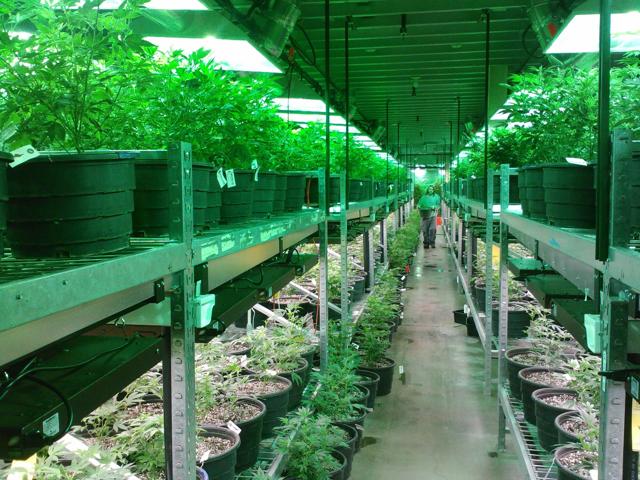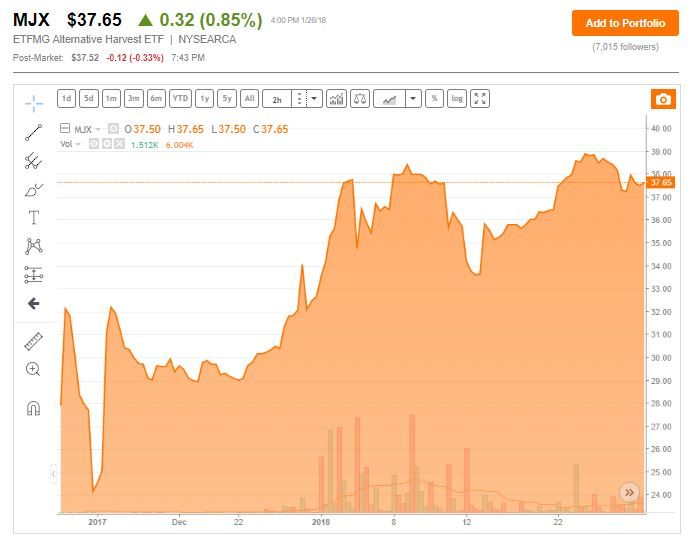Summary
- The global medical marijuana market is projected to reach $55.8 billion by 2025, according to Markets and Research.
- The ETFMG Alternative Harvest ETF has advanced 8% YTD vs. 3% for the S&P.
- Horizons Marijuana Life Sciences ETF, lit up 14% YTD.
 If U.S. investors follow in the footsteps of their Canadian counterparts, the ETFMG Alternative Harvest ETF (MJX) should grow like a weed. The Horizons Medical Marijuana Life Sciences ETF, listed on the Toronto stock exchange, has attracted roughly $554 million USD (690 million CAD) since it debuted in April.
If U.S. investors follow in the footsteps of their Canadian counterparts, the ETFMG Alternative Harvest ETF (MJX) should grow like a weed. The Horizons Medical Marijuana Life Sciences ETF, listed on the Toronto stock exchange, has attracted roughly $554 million USD (690 million CAD) since it debuted in April.
“I see this as something like the early days of the internet where many companies failed and a few grew into massive success stories,” says Anthony Welch, president of Sarasota Capital Strategies in Osprey, Fla. “As with the internet, the makeup of a cannabis fund today will look much different than the same fund 20 years from now.”
The ETFMG Alternative Harvest ETF, which rolled out Dec. 26, has advanced 8% year to date versus 3% for the S&P 500, through Jan. 16, according to Morningstar. Its Canadian counterpart with many overlapping holdings, the Horizons Marijuana Life Sciences ETF, lit up 14% year to date. It trades over the counter in the U.S. under the ticker HMLSF.
The ETFMG Alternative Harvest ETF tracks 30 companies “likely to benefit from the increasing global acceptance of various uses of the cannabis plant.” Don’t jump aboard unless you like roller coasters because it will likely be very volatile.
Market Potential Bigger Than Cable
ArcView Market Research projects the compounded annual growth rate, CAGR, of the so-called green rush will be faster than cable TV in the 1990s. The firm forecasts the North American cannabis market will go from $6.7 billion in 2016 to $22.6 billion in 2021 — an eye-popping CAGR of 27%.
“Very few consumer industry categories reach $5 billion in annual spending and then post anything like 25% compound annual growth across the following five years,” Arcview wrote in a report. “Cable television came close, growing 19% annually in the late 1980s as national networks like CNN and HBO proved to be wildly popular.
“Broadband internet subscription spending grew 29% per annum in the early 2000s as it became almost as much of a ‘must have’ utility as electricity or television for the modern home.”
The global medical marijuana market is projected to reach $55.8 billion by 2025, according to Markets and Research.
State Jobs and Tax Windfalls
In the U.S., recreational marijuana use is legal in the District of Columbia and eight states: Alaska, California, Colorado, Maine, Massachusetts, Nevada, Oregon, Washington. Cannabis use of some form, i.e., medical, is legal in 29 states.
Colorado‘s Department of Revenue reports taking in $159 million in taxes, licenses and fees this calendar year as of August. The Centennial state has made more than half a billion in tax revenue since legalization in January 2014, according to VS Strategies, a lobbying firm specializing in marijuana policy.
California — the most populated state with nearly 40 million and the sixth-largest economy in the world — expects to generate $1 billion from recreational marijuana. These mouthwatering numbers will prove irresistible to states. It’s only a matter of time before political pressure goads the remaining 21 states into following suit.
American’s approval of legalizing pot has risen gradually over the past 47 years and reached its highest level ever at 60% in 2016, according to a Gallup poll. The approval rating soars to 77% for 18- to 34-year olds.
“The transformation in public attitudes about marijuana over the past half-century has mirrored the liberalization of public attitudes about gay rights and the same-sex-marriage movement, the latter of which the U.S. Supreme Court deemed legal last year,” Gallup wrote.
Consumer Spending
A study conducted by LendEDU titled, Money Behind Marijuana, found that half of the legal users of recreational marijuana budget it into their monthly expenses. Here are other discoveries from the poll of some 1,000 users:
- The average recreational marijuana consumer spends $111.05 per month on marijuana products and buys 6.22 marijuana products every month.
- 28% of those polled said they pay more monthly on marijuana than eating out.
- 59% of respondents said their monthly marijuana spending has decreased while 54% said the number of purchases per month had gone up.
Health Benefits
Medical marijuana advocates have long touted its efficacy for treating nausea, pain, inflammation, loss of appetite, muscle spasms, insomnia and many other health problems. Research has proven its effectiveness for patients afflicted with autoimmune disorders, cancer, Crohn’s disease, glaucoma, HIV/AIDS, inflammatory bowel disease, multiple sclerosis, post-traumatic stress disorder (PTSD), seizures.
Tests done in the lab and on animals showed that Cannabidiol, or CBD, a non-psychoactive, non-toxic chemical in cannabis, stopped cancer cells from spreading, according to a 2007 study published in Molecular Cancer Therapeutics.
For recreational users, marijuana has been unjustifiably demonized. The U.S. Drug Enforcement Agency, DEA, classifies it with heroin, LSD, meth. But it’s undeniably far safer than alcohol and tobacco and is far less addictive. The most harmless recreational drugs, according to the Global Drug Survey 2017, are hallucinogenic mushrooms and marijuana.
No deaths have ever been attributed to marijuana. Whereas Centers for Disease Control and Prevention (CDC) tallies about 88,000 alcohol-related deaths annually. Excessive alcohol consumption over time can lead to life-threatening illnesses. Here’s a few as listed by the CDC:
- “High blood pressure, heart disease, stroke, liver disease, and digestive problems.
- Cancer of the breast, mouth, throat, esophagus, liver, and colon.
- Learning and memory problems, including dementia and poor school performance.
- Mental health problems, including depression and anxiety.
- Social problems, including lost productivity, family problems, and unemployment.
- Alcohol dependence, or alcoholism.”
Tobacco kills 480,000 every year and is to blame for about one in five deaths. Considering the CDC has identified caffeine as the cause of 51 deaths, caffeine pills are even more lethal than cannabis.
Cannabis overdose is impossible, physiologically. Marijuana doesn’t depress breathing. Whereas opioid overdosage stops breathing, thereby shutting off oxygen to the brain, initiating a domino effect on other organs.
“Because cannabinoid receptors, unlike opioid receptors, are not located in the brainstem areas controlling respiration, lethal overdoses from Cannabis and cannabinoids do not occur,” says the National Cancer Institute, a division of the National Institutes of Health.
Very High Investment Risks
The risks of investing in the U.S. cannabis industry surpasses any other emerging industry considering the conflict between state laws and federal laws. U.S. Attorney General Jeff Sessions sparked a selloff party Jan. 4 when he announced he’s retracting the Cole Memo, which lets individual states legalize cannabis without fear federal prosecutors will go after companies for trafficking.
“Industry insiders are moving assets and halting projects, even in Colorado where we have had legalized medical and recreational use marijuana for years,” said Scott Martinez, a partner at Snell & Wilmer. “I can imagine a scenario where Sessions goes after the most prominent marijuana-related business first, to send a message that no other business is safe.”
Sessions announcement was widely condemned by lawmakers on both parties. California Attorney General Xavier Becerra and his counterparts in other states assured they will support the legal cannabis markets.
“In California, we decided it was best to regulate, not criminalize, cannabis,” Becerra said in an emailed statement. “Unlike others, we embrace, not fear, change. After all, this is 2018, not the 20th century. At the California Department of Justice, we intend to vigorously enforce our state’s laws and protect our state’s interests.”
Sessions’ stance may be a boon for Canadian cannabis companies. Canadian cannabis companies are treated like any other Canuck business and have the freedom to grow overseas without any threat of U.S. competition. Canadian marijuana companies have legal access to crop insurance, bank loans, tax write-offs and licenses to export and expand overseas. Whereas U.S. marijuana companies don’t because the drug is illegal under federal law. Canada intends to fully legalize marijuana by July 2018.
“Canada is already, without question, the global leader in the legal cannabis industry, and this is due largely to our own federal government’s support of sensible legalization policy,” said John Arbuthnot, CEO of Delta 9 Cannabis in Winnipeg. “That support is allowing companies to expand both in Canada and now throughout the world, whereas American companies are being held back.”
Arbuthnot added: “There is a demonstrated interest among investors globally to invest in cannabis companies, which is only logical given the rapid growth of this industry.
“But right now, due to the stated US policy, Canadian companies remain the only safe haven for cannabis investors.”
Disclosure: I am/we are long MJX.
I wrote this article myself, and it expresses my own opinions. I am not receiving compensation for it (other than from Seeking Alpha). I have no business relationship with any company whose stock is mentioned in this article.
Additional disclosure: As the CMO of Firefly 420 Inc, I am very bullish on the cannabis industry.




